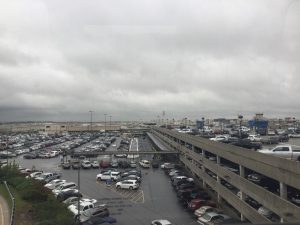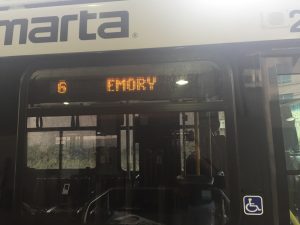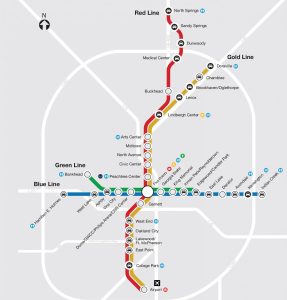After a short plane ride back from Chicago, I was left in the Hartsfield-Jackson International Airport with one of two options: I could either take an Uber and get back to campus quickly, or I could try to find a cheaper alternative. Using what I learned in my Economics class, I came to the smart decision of taking MARTA. Even though I knew it would take an extra hour to get back to Emory, I decided to go ahead with it. Not only was the trip easy, but it was also borderline enjoyable.

I started off by asking the help desk in the airport where to go since it is so massive. Sure enough, they told me to follow the big signs that said “MARTA Station”. After making my way through the terminal, I found some machines where I could buy a ticket. I looked though my wallet only to realize that I had left my day pass, which were so generously given to us, in my room back on campus. However, this didn’t really bother me at all since I knew how much money I was saving. I scanned my ticket, went up the escalator and hopped on a train that was waiting in the station already.

Airport station is a terminal stop on MARTA’s red and gold lines, which run north-south. This meant that the only people I saw on the train were airport workers and a lady with some luggage, who seemed to be in my situation. After a solid three minutes of standing still, the train doors closed and we moved out of the station. To my surprise, most of my train ride was above ground. I managed to get a unique view of certain parts of the city from the train, and when I got off I could feel my neck hurting from staring out the window.

After 13 stops, my train finally got to my station, Lindbergh Center. I took all my belongings with me upstairs to go catch the bus that would take me to campus. To my luck, there happened to be a #6 Emory/Oxford Rd waiting in the station. I sat down in the back of the bus and we departed for campus. I engaged in conversation with a young man sitting next to me. He told me, “You can get anywhere here for $2.50. I even got on for free because I convinced the driver I have no money, but…” he concluded, pointing to his pocket. Eventually, I started to recognize the area that I was in, so I requested a stop and got off the bus next to the WoodRec. I headed back to my dorm room, very pleased with myself having saved so much money.
Taking such a long ride on MARTA made me compare and contrast it with the transit system in my hometown, the Toronto Transit Commission (TTC). I was interested in public transit at a young age, so I like taking busses and trains whenever I go someplace new. The first thing I noticed about MARTA was that its vehicles were very clean. There is a no eating or drinking policy on all MARTA vehicles, which makes it less at risk to spills, which probably wouldn’t be cleaned up for a while. Another good addition to MARTA is the “Intercom tour guide”. At every train station, there is an automated announcement that tells passengers the main attractions nearby the station. This is super helpful in figuring out where you are, especially for someone like me who doesn’t know the city at all.
While my experience on MARTA was far from dreadful, I do think that there are some improvements to be made. First of all, I do not think that having overlapping lines is efficient for moving people. It makes stations get more crowded because people have to wait for specific trains, and it leaves only one station (Five Points) for people to transfer between the north-south lines and the east-west lines. In fact, all but one of the green line’s stops are shared with the blue line. I feel like the TTC has done a much better job of figuring out how to effectively get people from point A to point B. One more problem that I have with MARTA is that the bus and train are separated from each other. While the bus stops at train stations, you need to exit the actual station in order to board a bus. The TTC has busses pull into an area which is exclusive for people who have either come off a train/streetcar or paid to enter the station, so no transferring is necessary. This is more efficient for boarding vehicles during rush hour, when there are large crowds. While these are more big-picture problems, there are also some little things that annoyed me, like how the bus doesn’t announce stops like the train does, or how it closes at 12:30 am on weekends.


The bottom line is that MARTA is cheap and useful if you have a lot of time on your hands like I did. I personally think that it could use a bit of revamping, since the last time it was really useful was the 1996 Summer Olympics. Even though I may have made out the TTC to be so much better, I am pretty biased. After all, an article on jalopnik.com rates Toronto as the fifth worst public transit system in the world, with Atlanta only being fourth on the list. As a college student, I would really like to see MARTA improve so I’d stop having to pay so much for Uber.
Jalopnik article: https://jalopnik.com/the-worlds-ten-worst-public-transit-systems-657407658
